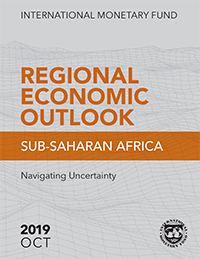
Sub-Saharan Africa
Sub-Saharan Africa Regional Economic Outlook: Navigating Uncertainty
October 2019
Full Text Country Focus
Background Paper and
Expanded
Statistical Appendix Tables
Executive Summary
Growth in sub-Saharan Africa is projected to remain at 3.2 percent in 2019 and rise to 3.6 percent in 2020. The expected recovery, however, is at a slower pace than previously envisaged for about two-thirds of the countries in the region, partly due to a challenging external environment. Growth is projected to remain strong in non-resource-intensive countries, averaging about 6 percent. As a result, 24 countries, home to about 500 million people, will see their per capita income rise faster than the rest of the world. In contrast, growth is expected to move in slow gear in resource-intensive countries (2½ percent). Hence, 21 countries are projected to have per capita growth lower than the world average. Reducing risks and promoting sustained and inclusive growth across all countries in the region requires carefully calibrating the near-term policy mix, building resilience, and raising medium-term growth.



